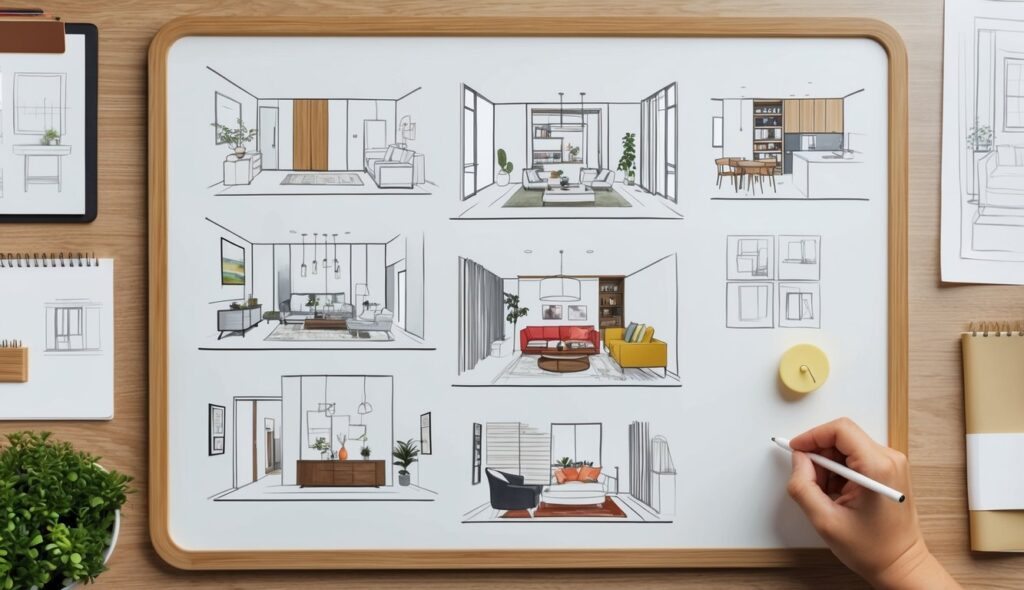Teak furniture has long been a favorite for mid-century modern designed homes due to its incredible durability and natural beauty.
Remember to repin your favorite images!
Teak’s natural oils and tight grain make it highly resistant to weather, pests, and decay, setting it apart from other woods.
This durability ensures that teak furniture can last for decades with minimal maintenance.
Mid-century modern design, which flourished from the 1940s to the 1960s, often incorporated teak due to its sleek, refined appearance.
Designers appreciated its ability to be handcrafted into airy, sinuous pieces that perfectly complemented the low-slung profile of the era’s aesthetic.
Additionally, teak daybeds continue to be a popular choice for both indoor and outdoor spaces, offering both style and comfort that aligns with mid-century modern principles.
Moreover, the timeless appeal of teak extends beyond just its durability and design compatibility.
The wood’s rich, warm color adds a touch of elegance and sophistication to any room, enhancing the overall ambiance.
As such, teak remains a sought-after material for anyone looking to infuse their home with the quality and beauty characteristic of mid-century modern design.
The Harmony of Teak with Mid-Century Modern Aesthetics
Teak wood’s natural qualities and visual appeal have made it a standout choice for mid-century modern homes. The material’s compatibility with clean lines and organic forms underscores its prominence in this design movement.
Influence of Mid-Century Design Movements
Mid-century modern design originated in the mid-20th century, emphasizing simplicity and functionality.
One of its key characteristics is the use of natural materials like teak.
The movement started in Scandinavia and quickly spread worldwide, largely due to designers who preferred materials that provided both durability and aesthetic appeal.
Teak’s resistance to weather, pests, and decay made it suitable for various applications, from shipbuilding to furniture design.
Its rich color and fine grain perfectly fit the mid-century emphasis on natural beauty and streamlined forms. This reinforced the mid-century modern principle of creating functional yet visually pleasing spaces.
Prominent Designers and Iconic Teak Creations
Several designers became synonymous with mid-century modern movements through their innovative use of teak.
Charles and Ray Eames, for example, created the iconic teak lounge chair and ottoman, celebrated for its comfort and sleek lines.
Hans Wegner, another influential figure, designed the teak Peacock Chair, known for its elegant, organic curves.
Arne Jacobsen’s designs, like the teak Ant Chair, combined simplicity with luxurious materials.
These creations highlighted teak’s versatility and how it could be transformed into timeless pieces.
Similarly, Westminster Teak offers modern examples, ensuring the legacy of high-quality teak furniture continues today.
Principles of Form and Function in Teak Furniture
Mid-century aesthetics focus on the balance between form and function.
Teak furniture embodies this balance with its clean lines, practical designs, and organic forms.
The wood’s natural oils contribute to its durability and low maintenance, aligning with the mid-century ideal of creating long-lasting and easy-to-care-for furnishings.
Tables and chairs designed from teak often exhibit slender, tapered legs and minimalist frames, enhancing the modernist approach.
For example, the best teak coffee tables showcase these principles by offering sturdy surfaces with elegant appearances.
By integrating these principles, teak furniture ensures spaces remain uncluttered and airy, which is essential to the mid-century modern aesthetic.
Durability and Sustainability of Teak in Modern Homes
Teak is known for its impressive durability and eco-friendly qualities. These features make it a popular choice for mid-century modern homes.
Advantages of Teak Over Other Materials
Teak furniture stands out due to its strength and durability.
The natural oils in teak wood make it highly resistant to decay and insects, giving it a clear edge over other materials like pine or oak. This makes teak ideal for both indoor and outdoor furniture, including teak shelving.
Unlike other woods, teak does not warp or crack easily even when exposed to direct sunlight or varying climates.
This stability makes teak a long-lasting choice for pieces such as a dining table or a patio set. Its dense grain also adds to its structural integrity, making it a solid investment for any home.
Care and Maintenance for Longevity
Proper care of teak furniture is key to preserving its beauty and longevity.
Regular cleaning with mild soap and water keeps it looking fresh.
Avoid using harsh chemicals that can strip away the natural oils and weaken the wood.
To maintain its golden hue, it’s recommended to apply teak oil or varnish every few months.
This not only enhances its appearance but also protects it from moisture and stains.
For indoor furniture like a dining bench, it’s advisable to place it away from direct sunlight to prevent any fading.
Teak’s natural resilience requires minimal upkeep, making it a practical choice for busy households.
Even a simple teak shower bench can retain its elegance and utility with proper care.
Contemporary Environmental Considerations
Teak is not just durable; it’s also a sustainable option when sourced responsibly.
The best practices include using teak from managed plantations, where trees are harvested and replanted systematically. This helps mitigate the risks of over-harvesting and ensures a renewable supply of this valuable wood.
Many modern teak furniture makers prioritize eco-friendly practices.
Sustainable teak collections feature lower environmental impact, aligning with the growing need for environmentally conscious choices in home decor.
Supporting these practices helps maintain the balance between quality craftsmanship and environmental integrity.
Teak furniture combines durability, minimal maintenance, and sustainability, making it a standout option for modern and mid-century homes.

